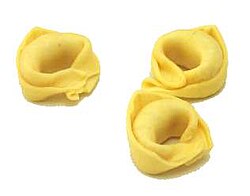Tortellini
 The distinctive shape of tortellini | |
| Alternative names | Belly button |
|---|---|
| Type | Pasta, Dumplings |
| Place of origin | Italy |
| Region or state | Emilia |
| Variations | Tortelloni |
Tortellini are ring-shaped pasta, sometimes also described as "navel shaped", hence their alternative name of "belly button" (ombelico).[1] They are typically stuffed with a mix of meat (pork loin, prosciutto) or cheese. Originally from the Italian region of Emilia (in particular Bologna and Modena), they are usually served in broth, either of beef, chicken, or both.[2]
Packed, refrigerated or frozen, tortellini and tortelloni (similar but larger, with cheese and/or vegetable stuffing) appear in many locations around the world, especially where there are large Italian communities. Tortellini and tortelloni are made in European industrial lines supplying markets in Europe and further afield. "Fresh" packed tortellini usually have 7 weeks of shelf-life.
Origins
The origin of tortellini is obscure although many legends lay claim to the origins of it. A strong local tradition has it that this dish was born in Castelfranco Emilia (province of Modena).[3] One night during a trip, Lucrezia Borgia stayed at an inn in the small town and during the night the host became so captivated by Lucrezia's beauty that he could not resist the urge to peek into her room through the keyhole. The bedroom was lit by only a few candles, and so he could barely see her navel. This pure and innocent vision was enough to send him into an ecstasy that inspired him to create the tortellini that night.

Another legend, distinct but similar in theme, originated in medieval Italy and tells how Venus and Jupiter arrived at a tavern on the outskirts of Bologna one night, weary from their involvement in a battle between Modena and Bologna.[3] After much food and drink, they shared a room. The innkeeper, captivated by the two, followed them and peeked through the keyhole. All he could see was Venus's navel. Spellbound, he rushed to the kitchen and created tortellini in its image.

Finally, a third explanation claims that the tortellini reproduce the shape of a turtle in an effort to replicate the famous architectural features of Modena, where many 17th-century buildings allude to the turtle motif.[3]
Comparison to tortelloni
Tortelloni is pasta in the same shape, but larger, typically 5 g, vs. 2 g for tortellini.[4] Although either can be filled with a wide variety of foods, meat-based filling is less common in tortelloni. Tortellini may be served with sauce or in a broth; tortelloni are rarely served in a broth.
Nutrition Data
Tortellini pasta, with cheese filling, fresh-refrigerated, as purchased
| Nutrient | Unit | 1 Value per 100g | Amount per 0.75 cup (81g) |
|---|---|---|---|
| Calories | 307 | 249 | |
| Proximates | |||
| Water | g | 30.50 | 24.70 |
| Protein | g | 13.50 | 10.94 |
| Total lipid (fat) | g | 7.23 | 5.86 |
| Carbohydrate, by difference | g | 47.00 | 38.07 |
| Fiber, total dietary | g | 1.9 | 1.5 |
| Sugars, total | g | 0.95 | 0.77 |
References
- ^ The Oxford Companion to Italian Food by Gillian Riley
- ^ Official "Order of the Tortellino" Recipe for Tortellini
- ^ a b c "Mushroom and Mozzarella Tortellini". Ang Sarap. Retrieved 18 February 2012.
- ^ Barilla US (manufacturer) FAQ
- ^ "Tortellini Nutrition data". USDA. USDA. Retrieved 30 September 2015.
